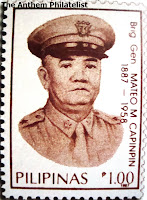The Philippine National Anthem
 On June 5, 1898, a week before Philippine independence would be declared, Julian Felipe, a local pianist from Kawit, Cavite, arrived at the home of Maximo Inocencio, one of Cavite's thirteen martyrs during the revolution. Upon his arrival, the leader of the revolution, General Emilio Aguinaldo, asked Felipe to play a march written by a Filipino in Hong Kong. However, Aguinaldo was not satisfied with this march. Recognizing Felipe's skills, he asked him to compose a more soul-rousing tune that would install courage and patriotism in the hearts of every Filipino.
On June 5, 1898, a week before Philippine independence would be declared, Julian Felipe, a local pianist from Kawit, Cavite, arrived at the home of Maximo Inocencio, one of Cavite's thirteen martyrs during the revolution. Upon his arrival, the leader of the revolution, General Emilio Aguinaldo, asked Felipe to play a march written by a Filipino in Hong Kong. However, Aguinaldo was not satisfied with this march. Recognizing Felipe's skills, he asked him to compose a more soul-rousing tune that would install courage and patriotism in the hearts of every Filipino.On June 11, the day before the declaration of independence, Felipe arrived again and played his tune to the revolutionary leaders. The leaders unanimously approved it as the national hymn. Felipe called his work the "Marcha Filipina Magdalo."
On June 12, Felipe's tune was played during the hoisting of the Philippine flag at the historic window at the Aguinaldo mansion. The march was renamed the "Marcha Nacional Filipina," and immediately became the National Anthem. However, the anthem still lacked words. The next year, a young soldier named José Palma penned the poem "Filipinas" in Spanish, to match the music of the anthem. It was adopted as the official lyrics.
The Philippines were now under American rule, and as such, a suitable English translation was to be made of the anthem. The first translation was made by Paz Marquez Benitez of the University of the Philippines. However, the most popular version was written by Mary A. Lane and Senator Camillo Osias, known as the "Philippine Hymn." On December 5, 1938, the Philippine Congress passed Commonwealth Act 382, which made the anthem's English words official.
A Tagalog (the Filipino language) version of the words started appearing in the 1940's. In 1948, the Department of Education approved "O Sintang Lupa" as the national anthem's Filipino words. In 1954, Education Secretary Gregorio Hernandez, Jr., created a committee to revise the words. The new version, entitled "Lupang Hinirang," was adopted (a minor revision was made in 1962), and was confirmed in 1998 under a new national symbols law. The words were based on a translation from Spanish to Filipino by Felipe Padilla de Leon.
The new national symbols law, approved in 1998, confirmed the status of the Filipino version of the anthem, but not the English or Spanish version. Currently, the English and Spanish versions are not in use, as the law states that only the Filipino version shall be played, however, the official English and Spanish lyrics remain the works by Lane/Osias and Palma, repsectively, although they are not part of the official anthem.






